Histoire des Châteaux de la Loire
last update: 20 Nov. 2019
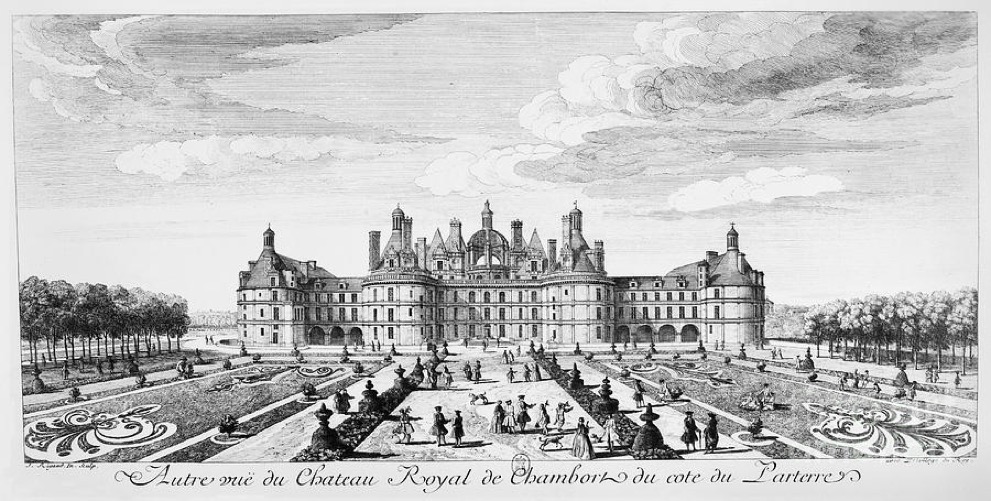
The Loire Valley, as the French say is a ‘haut lieu d’art et d’histoire’, and is today considered by UNESCO as “an outstanding cultural landscape of great beauty, containing historic towns and villages, great architectural monuments, and cultivated lands formed by many centuries of interaction between man and his physical environment".
I suppose the biggest question is why do we find such a unique collection of château’s in this one particular region of France?
In many ways it may be all down to the Romans
The Loire was part of Gaul during the Iron Age and the Roman era, and as far as I can see it sat on the frontier between Gallia Celtica and Aquitania. The entire region between the Seine and the Loire rivers was the territory of the Celtic tribes, the Cenomani (around Le Mans) and the Carnutes (around Chartres, Orléans and Blois). These peoples were not unsophisticated, and had certainly chosen the region because of its climate and potential to sustain a large tribe with food and water. By the time the Romans arrived these tribes had fortified towns, minted coins, effective political and religious (druidic) systems, and could muster an army of at least 12,000 fighting men. However these tribes also participated in the revolt against Caesar (100-44 BC), and shared in the defeat of the Gallic army. They were pacified, though not Romanised, as one of the peoples of Gallia Lugdunensis (as a Roman province), and retained their self-rule and the right to mint coins.
With the peace established under Augustus (63 BC to 14 AD) a period of stability and prosperity began. Angers (Juliomagus Andecavorum), Le Mans (Civitas Cenomanorum), Tours (Civitas Turonum) and Orléans (Aureliana Civitas) became increasingly like Roman towns each with a forum, theatre, baths and public buildings. Many agricultural estates (villae) were created or extended, and some of these estates were owned and run by influential religious figures. However by the end of the 3rd century both the power of the Roman empire was on the wane, and Christianity was growing stronger after being introduced by Saint Gatianus, the first bishop of Tours.
Then came the Franks
In the 5th century the Loire was invaded by the Huns (it is said that they first crossed the Rhine in 406), and in 451 Attila (ca. 406-453), helped by some Franks, Goths, and Burgundians, lay siege to Orléans. But Attila was defeated at the battle of the Catalaunian Plains by the Roman Flavius Aetius helped by the Visigoths and other Franks. It was Clovis (ca. 463-511), the first King of the Franks, that finally in 507 eliminated Visigoth power in Gaul, and became what many people see also as the first King of France (and his name Clovis is at the origin of the name Louis, later born by 18 French Kings). Below we have a map of France as it was in 511, at the death of Clovis.
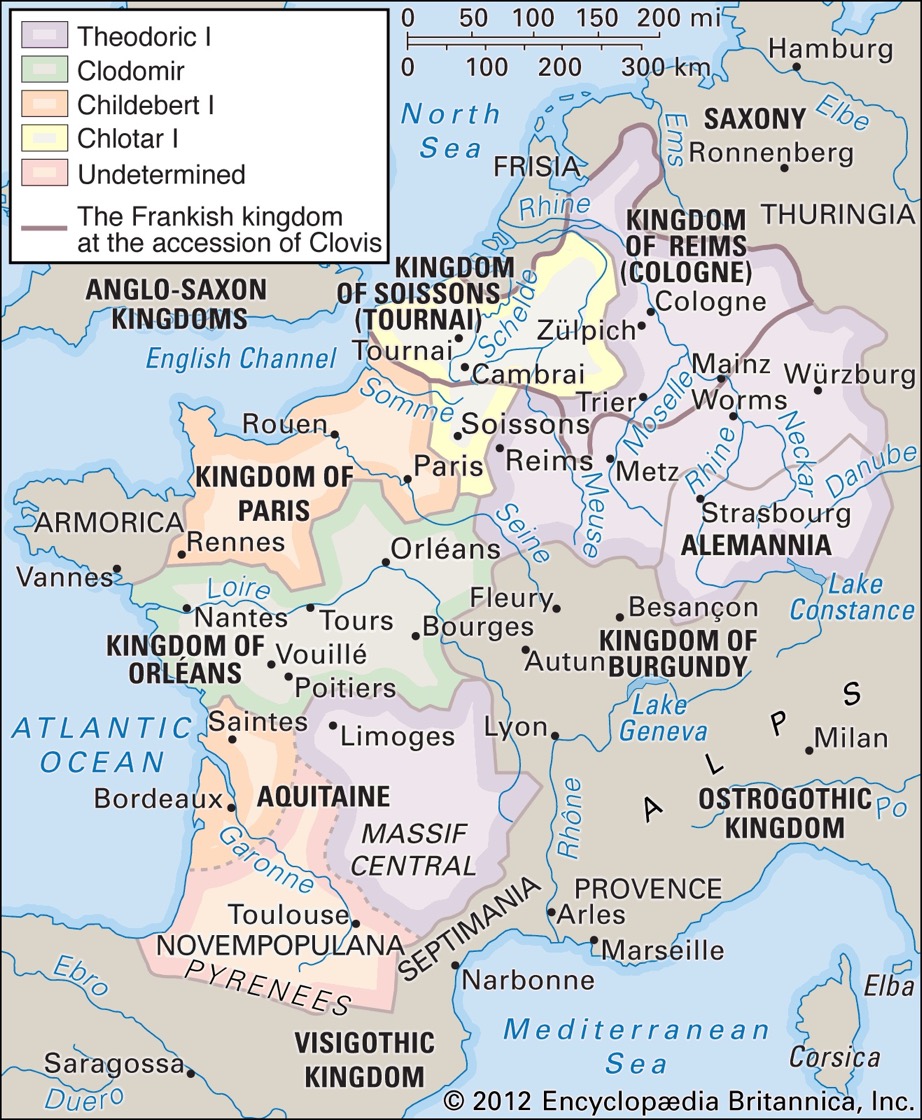
Clovis introduced Catholicism and established Lex Salica, a body of Frankish law which certainly survived well into the 9th C. We know much of what happened during this period thanks to Gregory of Tours (ca. 538-594), bishop of Tours and a historian, who by writing in Vulgar Latin ensured that his works survived through to today.
In 732 an army of Muslim horsemen from Al-Andalus reached Tours before they were repulsed by Charles Martel (ca. 688-741). Later one of his sons, Pepin the Short (ca. 714-768), would become the first of the Carolingian Kings. And later still his grandson, Charlemagne (ca. 742-814), would become the first Emperor since the fall of Rome. This did not stop Tours being attacked by the Viking in 732. They were repulsed, but having settled in the mouths of the Seine and the Loire, they came back in 852 and sacking the town.

The Baptistère Saint-Jean in Poitiers is reputed to be the oldest existing Christian building in France, and is an example of Merovingian architecture.
So during the Merovingian period (457-752) the country was protected by isolated strongholds. Some had evolved from fortified Gallo-Roman country estates, and others were newly built on high ground (e.g. Loches, Chinon). Generally they covered a fairly large area and served as residences of important people, a place of worship, a place for minting money, an agricultural centre and a place of refuge for the local population. This type of stronghold continued under the Carolingians, but the growing insecurity in the second half of the 9th century introduced a new wave of fortification in an attempt to counter the Viking threat.
Château de Loches
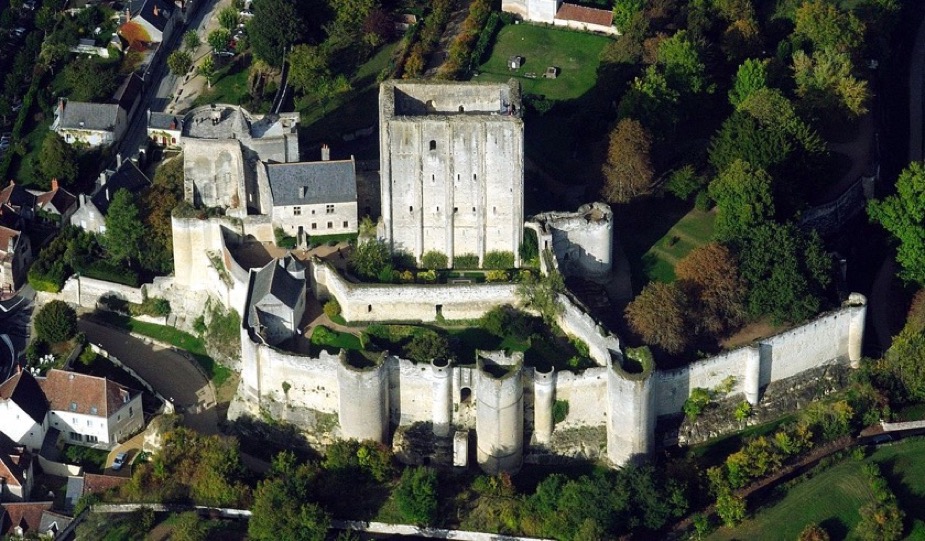
The 40 meter high “keep” (donjon) of the château of Loches has walls that are nearly 3 metres thick. It was built between 1013 and 1035, and towers over the River Indre. This castle was occupied by Henry II of England (1133-1189) and his son Richard the Lionheart (1157-1199), and later still it became a gift of Charles VII of France (1403-1461) to his mistress Agnès Sorel (1422-1450), before being turned into a prison by his son Louis XI (1423-1483). Louis XII (1462-1515) held Ludovico Sforza (1452-1508) there as a prisoner between 1500-1504, but he was allowed visitors and even could keep his own bouffon (jester). The additional inner defensive walls were added in the 12th and 13th centuries, and the outer wall, the dry moat and the barbacane (barbican or fortified gateway) were added in the 15th century.
Château de Chinon
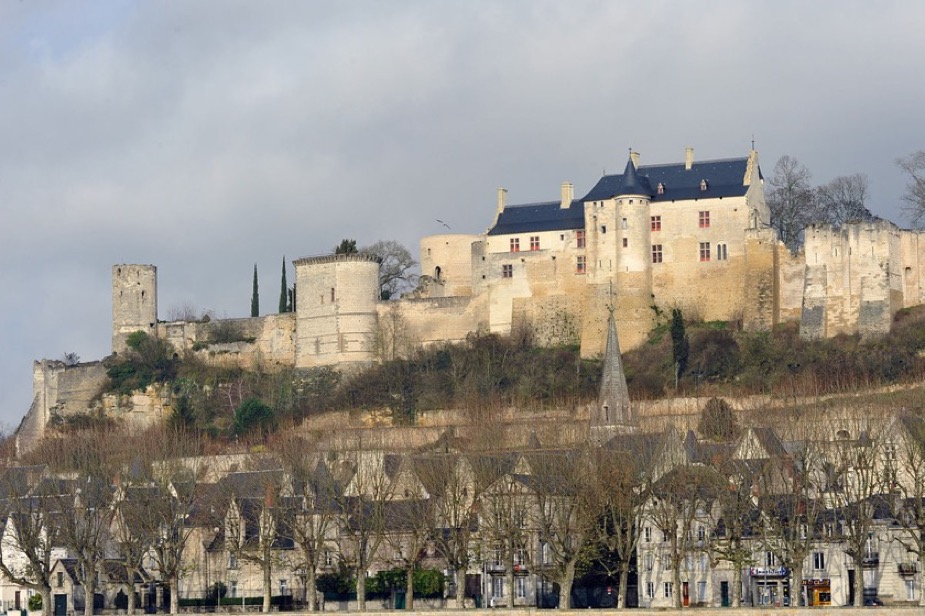
Château de Chinon (often called a Royal Fortress) is located at the crossroads of the three provinces of Anjou, Poitou and Touraine, and was built on the site of a Gallo-Roman castrum as a fortified stronghold by Theobald I, Count of Blois in the year 954. It was built on a promontory commanding the River Vienne and its valley. The position was so unique that traces of human occupation date back to palaeolithic times. And even before the Romans the site was a Celtic oppidum before being turned it into a fortress. During the 5th century it was also occupied by the Visigoths.
It was Henry II Plantagenêt (1133-1189), Count of Anjou and King of England, who gave château Chinon its current appearance by building a new palace on Fort Saint-Georges (he lived there until his death in 1189). Some experts have suggested that also Richard the Lionheart (1157-1199) might have died at Chinon. In any case in 1205, after a long siege, the King of France Philippe Augustus (1165-1223) gained control of the fortress and immediately added several towers. He built the 20 metre high “Coudray Fort” with its two massive towers (one can be seen in the background). Another tower (the “Tour du Moulin” on the extreme left) was built at the time of Henry II Plantagenêt and is equally powerful in its structure (20 metres high and 8 metres across). The third tower is the “Tour de Boisy” (in the middle with the lighter colour stone), with walls more than 30 metres high and 6 metres in diameter.
Chinon was also the place where in 1429 Jeanne d’Arc (Joan of Arc) came to persuade Charles VII (at that stage dauphin) to stand up to the English in France.
House of France
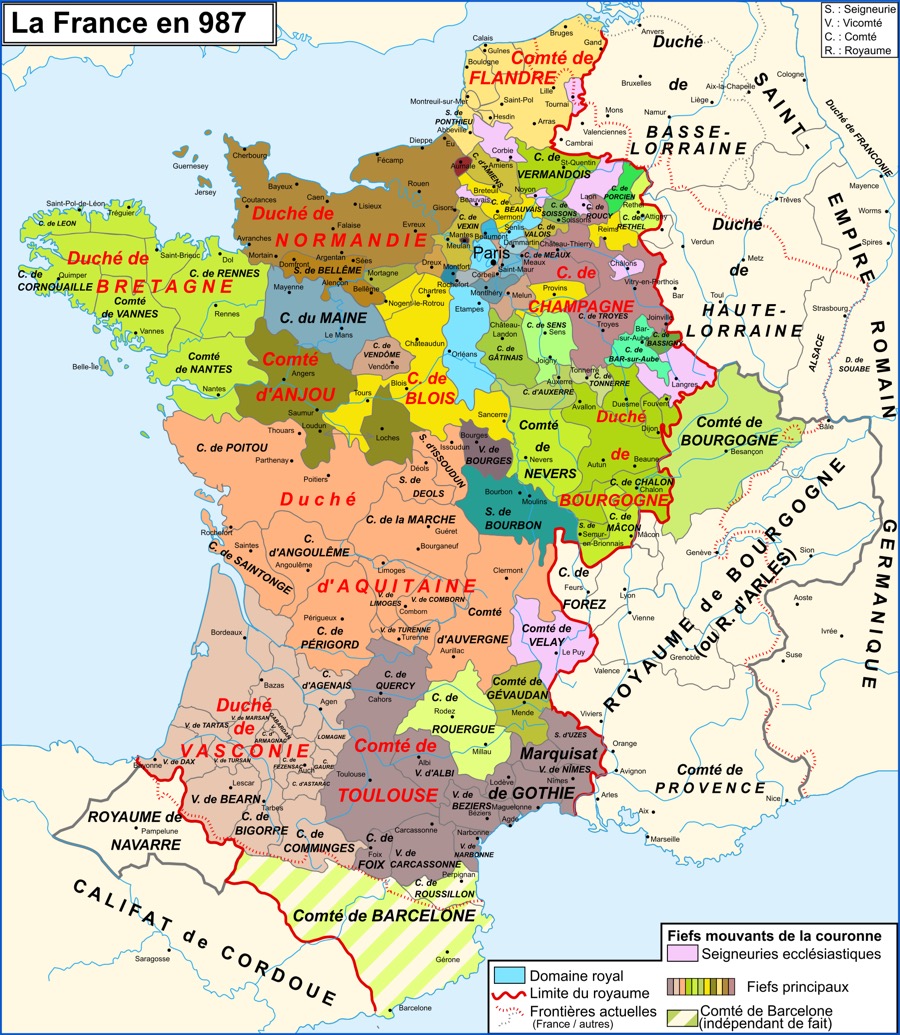
So with the death of Louis V in 987 we see the last of the Carolingian Kings of West Francia (ca. 840-987), and with the election of Hugh Capet, the appearance of the so-called Capetian Dynasty (987-1792). This dynasty is also often called the House of France, and it was also at the origin of both the House of Bourbon and the House of Habsburg. This France bore no resemblance to modern France, and Hugh Capet, the son of a powerful family of landowners, had his towns and estates (and thus his power base) in the Île-de-France and the Orléanais region (Orléans, Chartres, Blois). In fact the whole of Eastern France was ruled by the Ottonian dynasty, and Normandy, Burgundy and Brittany were all independent.
The reality was that France was a mess. The weakness of the last Carolingian Kings encouraged the independence of turbulent and ambitious feudal lords. The country was composed of fiefdoms, each with its own lord and codes of law. There were at least 150 different forms of currency and more than a dozen different languages spoken across the country. But Capet was Count of Paris, and it is from there that he began the long process of exerting power over the rest of the country. Successive kings of the Franks consolidate their scattered possessions by marriage, inheritance, acquisition, assassination, conquest, annexation, 'pacification', confiscation, and gifts. For example, Robert II (972-1031) bought the Duchy of Burgundy in 1016, Louis VII (1120-1180) married Eleanor of Aquitaine in 1137 and received Gascony and the Poitou as well, Charles VII (1403-1461) confiscated Amboise in 1432, and Brittany and France were unified in 1547.
Feudal France
Feudalism flourished in France in the 11th and 12th centuries in the region between the Seine and the Loire under the Capet monarchy. The system was based on two elements, the fief and the lord. The fief was a beneficium (benefice), usually in the form of a land grant made by a lord to a knight or other man who became his vassal. The numerous conflicts of interest which arose from the system in practice produced a detailed code of behaviour embodying the rights of the different parties. During the 12th century the services due were defined, such as the maximum number of days to be spent each year in military service or castle watch. Gradually the fiefs became hereditary and the lord retained only overall ownership. In the case of multiple vassalage, liege homage was paid to one lord and this was more binding than homage paid to any other.
So an almost perfect hierarchical pyramid was created descending from the king to the mass of simple knights. The more important vassals had the right of appeal to the king in the event of a serious dispute with their suzerain. For example, it was by this means that King John (1166-1216) was deprived of his French fiefs by Philippe Auguste early in the 13th century. All the inhabitants of an estate were involved in the economic exploitation of the land. The estate had evolved from the Carolingian method of administration and was divided into two parts, the domain, which was kept by the lord for himself, and the holdings, which were let to the tenants in return for rent. The authority exercised by the lord over the people who lived on his estate derived from the royal prerogative of the monarch to command his subjects, which then passed into the hands of powerful lords who owned castles. This unlimited power enabled them to impose military service, various duties (road mending, transport, etc.) and taxes on their tenants.
Looking at the city of Tours now, it is not easy to understand why it became both the seat of the archbishops and that of the Kings of France (and remained as such until the 16th century). Through to 1044 Tours was one piece on a chess board of battles and alliances between the counts of Blois, Anjou, Nantes, and the Dukes of Aquitaine and of Brittany. This was the age of powerful barons, who raised armies and minted money. From Orléans to Angers every high point was crowned by an imposing castle, the stronghold of the local lord who was continually at war with his neighbours. But in 1044 Geoffrey Martel (Geoffrey II, Count of Anjou) took possession of the Touraine, and he did so despite persistent threats from both William the Bastard (the Conqueror, the first Norman King on England) and Henry I of France (1008-1060).

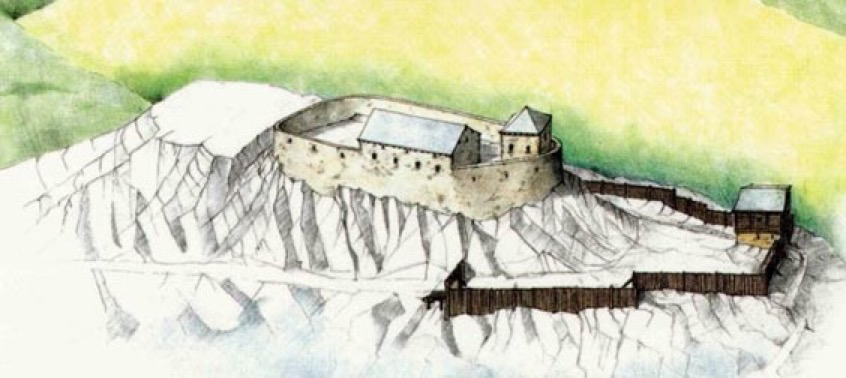
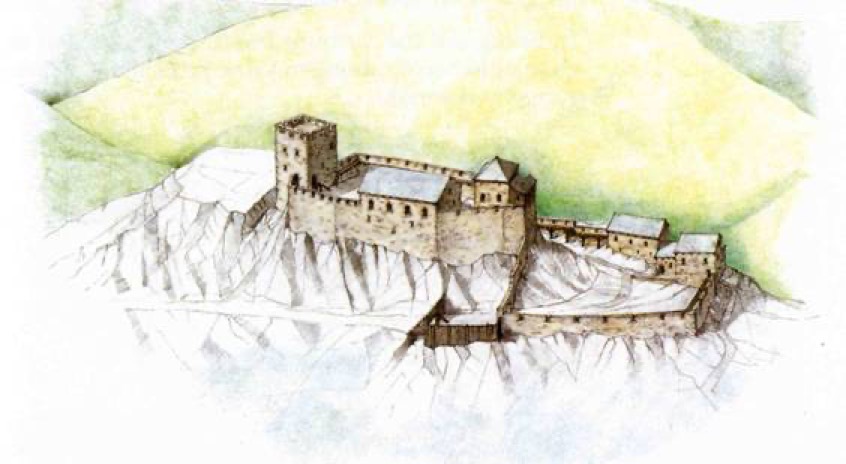
These early castles sat on a mound of earth, the “motte” surrounded by a wooden palisade, with the occasional tower as an observation post. The structure contained very little masonry, but starting in the 10th century local lords became more powerful and started to build small strongholds under the guise of towers – the “keep” had been invented. It quickly developed to include a storeroom for arms and food on the ground floor, a great hall on the first and living rooms on the upper floors. The compact shape and the height of the walls made it difficult to besiege and only a few men were needed to defend it. As time went on the “keep” was extended to protect a residential building that was often erected at the end of a promontory.
The House of Plantagenêt
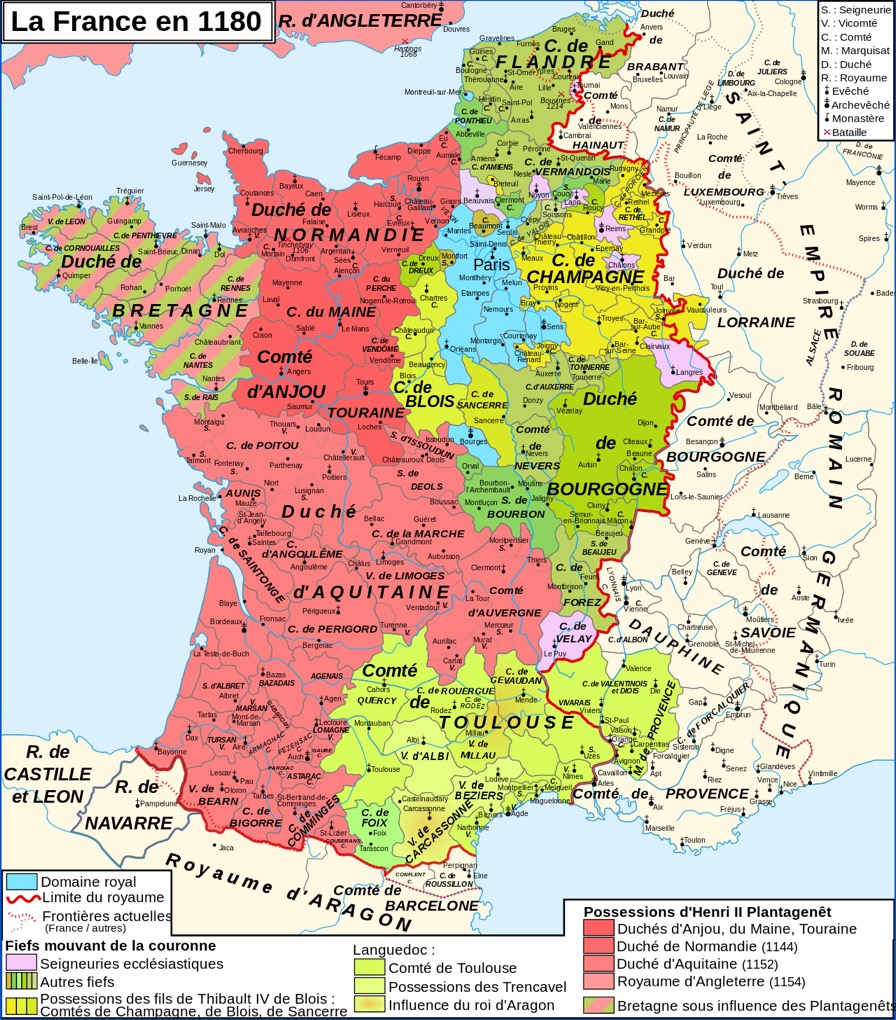
This was a period when every one of importance appeared to have an odd but very descriptive name, e.g. the Good, the Red, the Fat, the Lazy, the Pious, the Bastard, the Cross-looking, the Bearded, the Young, or the Handsome. Anyway the succession of Geoffrey Martel was difficult, but to cut a very long story short, Geoffrey V (the Handsome) or “Plantagenêt” became count of Anjou in 1129. He married Matilda, the daughter of Henry I of England (1068-1135), and his son, Henry Curtmantle (1133-1189), succeeded to the English throne and founded the Plantagenet dynasty (1154-1485).
The House of Plantagenêt is often also called the Angevin Empire (a name deriving from Anjou). Although “Empire” is a bit bold, it did describe an area consisting of England, Ireland, Normandy, Gascony, and the Aquitaine, and including Anjou, Poitou, Touraine, Périgord, Limousin, and at times Brittany, Wales and Scotland. Still keeping the story short, we are now in a long period where we still have Kings of the Franks, feudal struggles, problems of successions, political marriages and divorces, switching of allegiances, and on top of all that an emerging rivalry between England and France that was to last for centuries. Things would come to ahead with Philip II of France (1165-1223) and King John (1166-1216), and a truce in 1206 which would give Normandy and Anjou to the French King and leave England, Ireland and Gascony to the Plantagenêts (with Aquitaine also remaining English until 1453). In fact the castle of Chinon in the Touraine had been the Plantagenêts greatest stronghold, but now it was handed over to the King of France. It became a French royal estate (domaine royal), and was even the refuge of Charles VII in 1418 (and Joan of Arc saw him there in 1429).

An early drawing of the château of Beaugency
By the 11th century some castles had defensive works built of stone. However the keep was still the strongest point and took the form of a massive quadrangular structure, e.g. the keeps at Loches, Langeais, Montbazon, Chinon (Coudray) and Beaugency are remarkable examples of 11th century architecture. By the 12th century the stone curtain wall was gradually reinforced with turrets and towers. And the castles began to become small villages comprised private apartments, a great hall, one or more chapels, soldiers’ barracks, lodgings for the household staff and other buildings such as barns, stables, storerooms, kitchens, etc. In the 13th century, under the influence of the crusades and improvements in the art of attack, important innovations began to make their presence felt. Castles were designed to be even more compact with multiple defensive features so that no point was unprotected. The curtain wall bristled with huge towers and the 'keep' was neatly incorporated into the overall design. A circular plan was adopted for the towers and keeps, and the walls were splayed at the base. The depth and width of the moat were greatly increased. Sometimes a lower outer rampart was built to reinforce the main rampart, and the intervening strip of level ground was called the 'lists'. These 13th century castles, which were more functional and had a pronounced military character, could be built anywhere, even in open country. But at the same time a desire for indoor comfort began to express itself in tapestries and draperies and furniture (chests and beds), which made the rooms more pleasant to live in.
The Loire Valley becomes the seat of power
The Loire Valley was a rich agricultural land with a multitude of land owners. The feudal system in place was based upon alliances, but rivals quickly started to build defensive fortresses to protect themselves. The count of Anjou became one of the most powerful people in France, and his domains included Saumur and the Touraine. Defensive fortresses became fortified chateau’s and the first abbeys appeared. The first Kings of the Franks came from this region, and the Plantagenêts were born there.
Through the 12th century the royal court moved from one place to another, but Paris became the favoured capital. However Charles VII (1403-1461) stayed in the château’s of Loches and Chinon, and he also enlarged and fortified Amboise. During his reign he moved his court to the Loire Valley for extended periods, and Louis XI (1423-1483) spent some considerable time in Loches and Amboise, before installing himself in Tours as King of France. It was Charles d’Orléans (1394-1465) who, returning to France after being held prisoner by the English for 25 years, decided in 1440 to completely renovate the château of Blois. Charles VIII (1470-1598) followed his example, renovating Amboise and buying new Italian furniture. He had invaded Italy in 1494 (Pavia, Pisa, Florence, and Naples) and, although in 1495 he was forced to withdraw back to France, he clearly had taken a liking to Renaissance architecture and decorations. Later still Louis XII (1462-1515) also chose Blois as his royal residence and capital. François 1er (1494-1547) was also much attached to both Amboise and Blois, and in fact he added a wing to the latter château. He even brought Léonardo de Vinci (1452-1519) to Amboise, and Léonardo is buried there today. François 1er also built the château Chambord, which was designed to manifest the power of the French Kings.
So you can imaging that everyone of importance in France from 12th century through to the early 16th century would have wanted to build an impressive château near their king, and in fact it is said that today there are still more than 300 château’s to be found in the region.
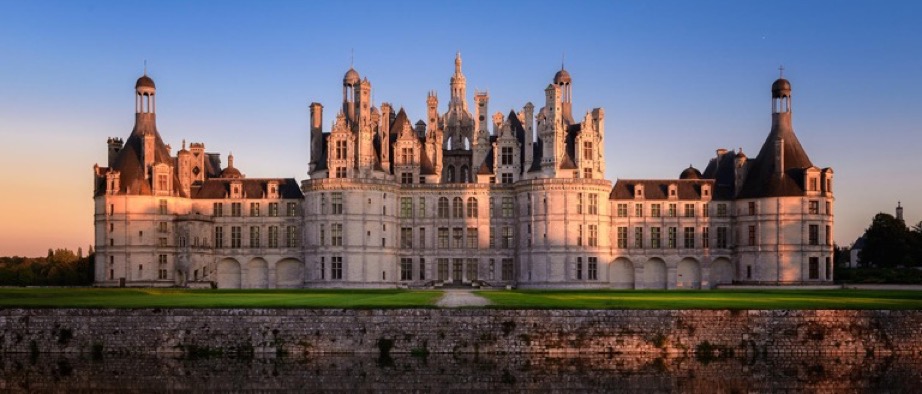
The château of Chambord
With castles in the 14th and 15th centuries the accent moved from defence to comfort and decoration. The living quarters were more extensive, with larger windows to let in the light. New, often highly decorated, rooms appeared such state bedrooms, dressing rooms and lavatories. In terms of defensive building there were only minor improvements. The “keep” merged with the living quarters and was surmounted by a watchtower, and occasionally the keep was suppressed altogether and the living quarters took the form of a rectangular block defended by huge corner towers. The entrance was flanked by two semicircular towers and protected by a barbican (a gateway flanked by towers) or by a separate fort. The top of the curtain wall was raised to the height of the towers which were often crowned by a double row of crenellations. In the 15th century the towers were capped by pointed, pepper-pot roofs.
Churches and monasteries, which were places of sanctuary and therefore targets of war, were also fortified, especially during the Hundred Years War (1337-1453). And towns and some villages also built ramparts round the residential districts. In fact in 1398, 1399 and 1401 Charles VI issued letters and ordinances calling for the owners of fortresses to maintain and develop their defences. From the end of the 13th century fortified houses were built in the country districts by the local lords of the manor, whilst having little military significance they were modelled as small château’s.
As an example of the shift to comfort and decoration we can look to Charles VIII as an example. During his escapade in Italy he acquired a considerable amount of furniture and numerous other decorative objects in order to embellish the interior of the Château d’Amboise. We know that he installed in the château hundreds of Persian carpets, Turkish woollen pile carpets, Syrian carpets, along with dozens of beds, chests, oak tables and dressers. The rooms and sometimes the courtyards (during prestigious events) were hung with sumptuous tapestries from Flanders and Paris. He also endowed the château with an extensive collection of beautifully crafted silverware, and a great many works of art, mainly from Italy. The Armoury (based upon the inventory of 1499) contained several sets of armour and outstanding weapons having once belonged to Clovis, Dagobert, Saint Louis, Philip the Fair, Du Guesclin and Louis XI.
The capital moves back to Paris
With Henri II (1519-1559) the château of Blois, and the Louvre in Paris, remained the seat of the royal court. However with the Amboise conspiracy (1560) and the assassination of Henry I, Duke of Guise in 1588 in the château of Blois, Henri III (1551-1589) decided to move his court to Tours. This move was confirmed and continued by Henri IV (1553-1610). After escaping at least 12 assassination attempts Henri IV finally moved his court back to Paris in 1594 (where he did much to restore Paris again as a great city).
Moving the court back to Paris essentially closed the “royal period” for the château’s in the valley of the Loire. But all was not lost!
Under François 1er (1494-1547) the French court became a model of elegance, taste and culture. Not only did he invite men of science, poets and artists to his court, but he also allowed women, who until then had been relegated to the Queen’s service, to take a more prominent role in public life. He expected them to dress perfectly and look beautiful at all times, and gave them the means to do so. He also ensured that these ladies were treated with courtesy and respect. A code of courtesy was established and the court set an example of good manners. François 1er divided his time between Amboise and Blois, and he later had Chambord built and spent the rest of his life there. The King’s suite or retinue included 200 gentlemen-in-waiting and over 1,000 archers and Swiss guards. He was passionate about hunting, and he also employed 125 people to keep his hounds and another 50 people to look after his hawks. Princes of the blood and great lords also had their households. Thus, from the time of François 1er, the royal entourage numbered about 15,000 people. When the court was on the move, 12,000 horses were needed. By way of comparison, in the 16th century only 25 towns in the whole of France had more than 10,000 inhabitants!
Under Henri II and his sons, Blois remained the habitual seat of the court when it was not at the Louvre palace in Paris. It was Henri III who drew up the first code of etiquette and introduced the title 'His Majesty', taken from the Roman Emperors. The Queen Mother and the Queen also had their courts and each would have had about 100 ladies-in-waiting. Catherine de’ Medici (1519-1589) also had her famous “flying squadron” of pretty girls (French noblewomen and maids of honour, and once also called “a stable of whores”), who kept her informed and assisted her in her intrigues. In addition she is said to have had 76 gentlemen servants, 100 pages to run messages, 51 clerks, 23 doctors and 50 chambermaids.
Whether they were queen or the current royal mistress, women at court played an increasingly important political role, while the lively festivities with which they surrounded themselves made a major contribution to the sphere of cultural and artistic influence of the royal court. As we visit the different château’s today we are constantly struck by the impact of women on the “newer” buildings, on the renovations, on the decorations, and on the luxury of the royal courts of the period.

Agnès Sorel (1422-1450) graced the court of Charles VII at Chinon and at Loches. She gave the king good advice and reminded him of the urgent problems facing the country after the Hundred Years War, while the Queen, Marie d’Anjou, moped in her castle.

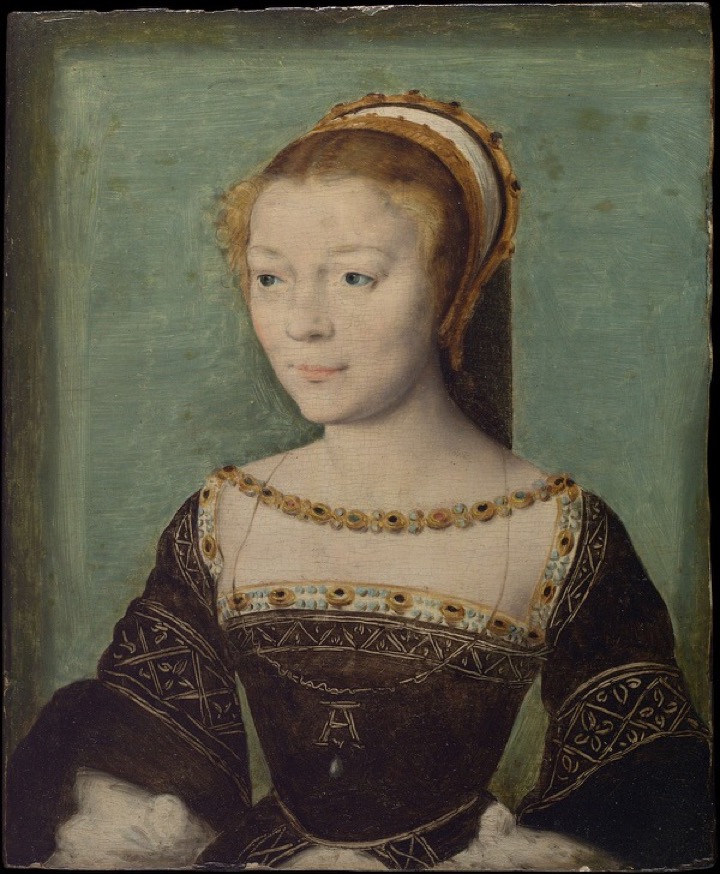
The love life of François 1er featured many women, including (top) Françoise de Foix (1495-1537) and (bottom) Anne de Pisseleu d’Heilly (1508-1580), who ruled his court until his death.
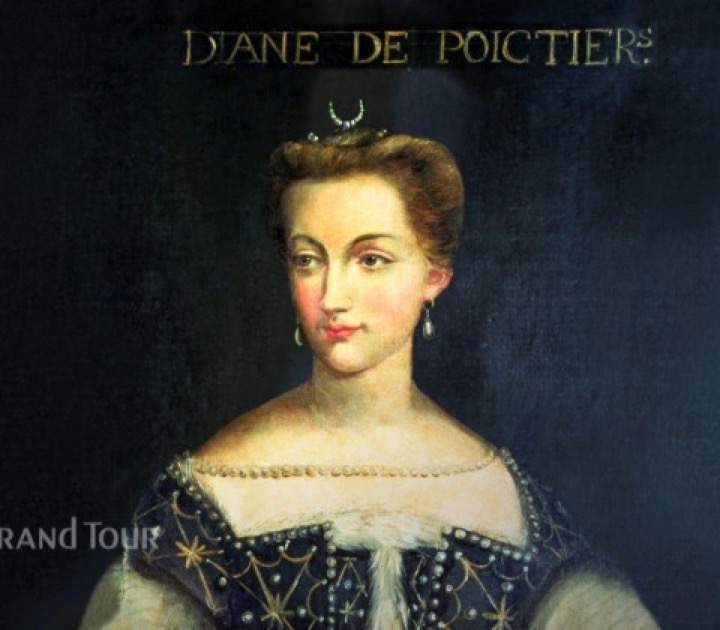
Diane de Poitiers (1499-1566), the famous favourite of Henri II, was a remarkably tough woman. She retained her energy, both physical and mental, well into old age, to the amazement of her contemporaries. She made important decisions of policy, negotiated with the Protestants, traded in Spanish prisoners, distributed honours and magistracies and, to the great humiliation of the Queen, saw to the education of the royal children. Such was her personality that almost every artist of the period painted her portrait.
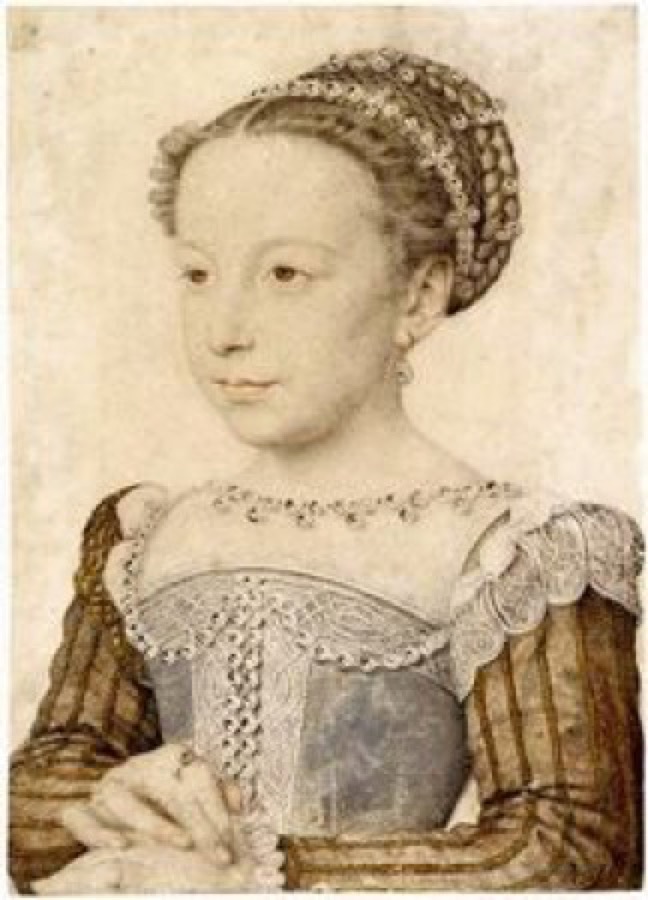
Marguerite de Valois (1553-1615), the famous Queen Margot, sister of François II, Charles IX and of Henri III was known for her exuberance and amorous escapades, and her marriage to the future King Henri IV did little to calm her down and was in any case later annulled.

Catherine de’ Medici (1519-1589) married the Dauphin Henri in 1533 and was a prominent figure at court for 55 years under five different kings. Although eclipsed for a while by the beautiful Diane de Poitiers, she had her revenge on the death of Henri II by taking Chenonceau from her and building the two-storey gallery across the River Cher. With the accession of Charles IX she became regent and tried to uphold the authority of the monarchy during the Wars of Religion (1562-1598) by manoeuvring skilfully between the Guises (Catholic) and the Bourbons, making use of diplomacy, marriage alliances and family intrigue.
French Renaissance
So it was Charles VIII, Louis XII and François 1er, having each visited Italy, who initiated the French Renaissance. These monarchs transformed the Loire Valley into a vast building site where the new aesthetic ideals flourished at Amboise, Blois and especially Chambord. The great lords and financiers followed suit and commissioned the building of elegant houses (Azay-le-Rideau, Chenonceau) while graceful mansions were erected in the towns. The Renaissance château was born, and military elements were abandoned in the search for comfort and aesthetic taste. Moats, 'keeps' and turrets became decorative features, as at Chambord, Azay-le-Rideau and Chenonceau. The spacious attics were lit by great dormer windows in the steep pitched roofs. The windows were very large. The spiral turret stairs were replaced with stairs that rose in straight flights in line with the centre of the main façade and beneath coffered ceilings. The gallery, a new feature imported from Italy at the end of the 15th century, lent a touch of elegance to the main courtyard. These new château’s were no longer built on hills, but were sited in valleys or beside rivers. Gardens were laid out like a jewel casket, and became an integral part of the overall design. Only the chapel continued to be built in the traditional style with ogive vaulting and flamboyant decoration.
The Renaissance excited not only intellectual activity, but also the need for a moral and religious revival. The Roman Catholic Church did not succeed in satisfying these aspirations, and Calvin (1509-1564), who stayed in Orléans between 1528 and 1533, was well received in cultivated circles. In 1540 the Church responded with repression, and the dispute between Protestants and Roman Catholics inevitably led to armed conflict. In 1560 the Amboise Conspiracy failed disastrously and ended in bloodshed. Catherine de’Medici tried to promote conciliation by issuing edicts of tolerance, but in April 1562 the Huguenots (Protestant Reformers) rose up, committing numerous acts of vandalism, damaging places of worship and destroying statues, tombs and relics.
The Roman Catholics regained the upper hand and exacted a terrible vengeance, particularly in Angers. From 1563 to 1567 there was relative peace, but in 1568 the armed struggle broke out anew. The Catholic and Protestant armies indulged in regular waves of violence. The inhabitants of Orléans suffered their own massacre of St Bartholomew (1572) with nearly 1,000 deaths. It took Henri IV (1553-1610) nearly 10 years to restore peace to the region. So the brilliant period in the history of the Loire Valley, which coincided with the last years of the Valois dynasty, ended in tragedy. The Loire country ceased to be at the centre of political and religious ferment in France, and the districts of Orléans and Tours were left to be administered by energetic treasury officials.
Let us have a look at all these different château’s
Some people have already tried to compile lists of the best and most beautiful, e.g. there is the official website of France, and then there is The Telegraph, About.com, plantware, Insight Guide, and the France Travel Guide (to name but a few). And of course, what would we be without the blogs, such as Frog+Princess, Expats, and Aussie in France. They all list the same handful of château’s, namely: Chambord, Amboise, Azay-le-Rideau, Blois, Chenonceau, Chinon, Chaumont, Meung, Valençay, Cheverny, Loches, and Ussé. Some also do a decent job in suggesting other attractions in the region, such as Orléans Cathedral, Le Mans Cathedral, Nantes Cathedral, Chartes Cathedral, or the gardens in Château de la Bourdaisière, Château de Villandry, Château de Beauregard, and Château du Rivau, or the Parc Oriental de Maulévrier, Jardin Camifolia, and the Jardin du Plessis-Sasnières.
According to official visitor figures, the 10 most popular attractions in the Loire region are Zooparc Beauval, then in order of visitors, Château Chambord, Château Chaumont, Château Cheverny, Château Blois, Château Azay-le-Rideau, Chinon, Château Langeais, La Source Orléans-Loiret, and Château Valençay.
So below we have a working list of the château’s in the Loire region. It was started with the list from Wikipedia, but I have expanded it using other lists found on the Web.
I am gradually hacking through the list and adding links and a uber-short description, and I hope one day to finish it …, but it's not high on my list of priorities…
Amboise (near Tours), 15th C royal residence and monument historique
Ancenis (between Angers and Nantes), 15th C fortress
Anet (west of Paris), 15th C château, restored in 19th C
Angers (In Angers), a 13th C fortress
Aprement (south of Nantes), Renaissance château in ruin
Château des Stuarts (Aubigny-sur-Nère), a 16th C castle open to visits in 2017
Azay-le-Rideau (near Tours), early French Renaissance architecture, built 1518-1527
Ballon (north of Le Mans), first mentioned in 11th C
Bastie d’Urfé (west of Lyon), 16th C Renaissance château
Baugé (east of Angers), a castle first mentioned in 11th C
Bazouges
Beaufort, originally a 13th C castle
Beaugency
Beauregard
Bégraisiere
Blain
Blois
Boisgibault
Bois-Briand
Bois Chevalier
Bois-Rouaud
Bois Thibault
Bouffay
Bouillé
Boumois
Bourgonniére
Bourmont
Bouthéon
Bretesche
Brézé
Bridoré
Briord
Brissac, originally a 11th C castle, rebuilt in the 15th C
Bury
Campbon
Candé
Caratel
Careil
Carheil
Challain
Chambord
Chamerolles
Champchevier
Champtocé
Chanteloup
Chassay
Châteaubriant
Chateau-dun
Châteauneuf-sur-Loire
Château-Thébaud
Chaumont
Chavagne
Chémery
Chenonceau
Chevenon
Cheverny
Chinon
Clermont
Clisson
Clos-Lucé
Conquereuil
Commequiers
Cornes d'Urfé
Courbe de Brée
Courtaliéru
Courtanvaux
Ducs de Bretagne
Dunois
Durtal
Echarbot
Épinay
Faucon Noir
Ferté
Fontenay
Fougères-sur-Bièvre
Frémoire
Freudière
Gascherie
Gien
Gazeux
Gilles de Rais
Goulaine
Goust
Grand Blottereau
Granville
Groslot
Gué-Péan
Guibourgère
Vieux-château de I’Île d’Yeu
Jallanges
La Bourdaisière
La Breuil de Foin
La Bussière
La Chatonnière
La Devinière
La Farinière
La Grand Pressing
La Guerche
Langeais
La Possonnière
La Roche
La Roche Racan
La Seigneurie du Bois
Lassey
La Thibaudière
Launay
Laval
Le Lude
Le Plessis-Macé
Les Réaux
Les Redrets
Lavoûte-Polignac
La Verrerie
Loches
Lucinière
Luynes
Madeleine
Mans
Mareuil sur Cher
Martigné Briand
Marcilly
Mayenne
Mélusine
Menars
Mercoeur
Mergot
Mesnerie
Meung-sur-Loire
Montbazon
Montgeoffroy
Motte-Glain
Montigny-le-Gannelon
Montjean
Montpoupon
Montrésor
Montreuil-Bellay
Montrichard
Montriou
Montrond
Monsabert
Montsoreau
Moricq
Mortiercrolles
Motte-Glain
Moulin
Palais Ducal de Nevers
Nitray
Noë de Bel Air
Noirmoutier
Oiselinière
Oudon
Pignerolles
Pimpéan
Pinelais
Plessis (Casson)
Plessis (Pont-Saint-Martin)
Plessis (Saint-Aubin-des Château)
Plessis-Bourré
Plessis-de-Vair
Plessis-Macé
Plessis-Mareil
Poirier de Beauvais
Pontchevron
Pornic
Portillon
Pouancé
Pouzauges
Raguin
Rairie
Ranrouët
Réaux
Retail
Rivau
Rochambeau
Rouvray
Saché
Saint-Brisson
Saint-Clair
Saint-Mars-de-coutais
Saint-Mars-la-Jaille
Sainte-Hermine
Sainte-Suzanne
Saint Jean du Grais
Saint-Loup-sur-Thouet
Saint-Pierre-la-Noaille
Saumur
Seilleraye
Serrain
Serrant
Sillé-le-Guillaume
Sully-sur-Loire
Talcy
Talmont-Saint-Hilaire
Thorigné-en-Charnie
Thouaré-sur-Loire
Tiffauges
Logis de la Touche
Touche
Tour
Troussay
Turmelière
Ussé
Valençay
Vallière
Valmer
Vendôme
Villandry
Villaumaire
Villejégu
Villelouet
Villeneuve
Villesavin
Vrillière
Source
http://en.wikipedia.org/wiki/List_of_châteaux_in_the_Pays-de-la-Loire
next Anjou
